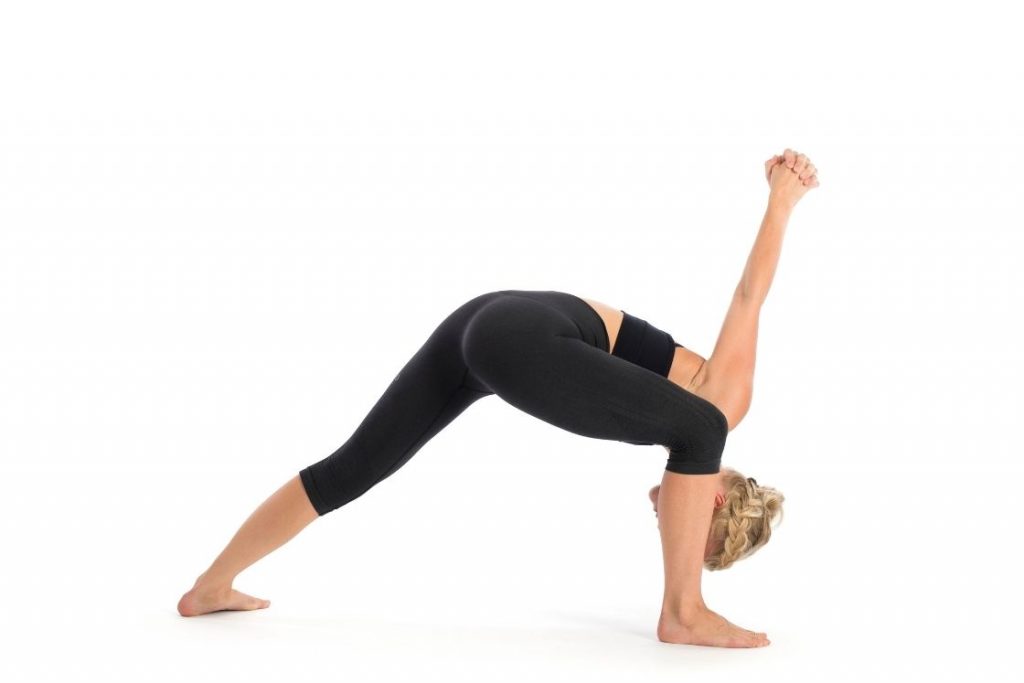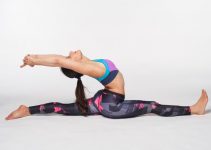
| Sanskrit Pronunciation | Baddha Virabhadrasana (Bad-Aha-veer-ah-bah-DRAHS-anna) |
| Meaning | Baddha = bound / Virabhadra = fierce warrior / asana = pose |
| Pose Type | Half standing and forward bend |
| Pose Level | Intermediate |
| Target muscles | Glutes & hip flexors, hamstrings, quadriceps and shoulders |
| Other Names | Devotional Warrior Pose, Silver Surfer Pose, Bound warrior pose |
The humble warrior pose is one of those poses which is a great hip and chest opener. The forward bending allows for the person to stay humbled and look inwards to reflect.
This pose is one of the intermediate poses as it requires you to use a lot of your core strength to stretch and stay balanced. In the series of Warrior pose, Humble warrior pose is a variation to the Warrior Pose I where you are in a lunge position and bend forward from the hips while stretching your arms behind.
All of these combined movements improve your digestion, stretch your arm and leg muscles and the head bending encourages you to focus inwards.
Humble warrior pose works on all 7 chakras;
- Root chakra as it is a great hip opener and grounding pose,
- Sacral chakra as the abdominal muscles are engaged improving the digestion,
- Solar plexus chakra due to the stretch of the pelvis and hip region,
- Heart chakra as your chest gets opened when you stretch your arms behind,
- Third Eye and Crown Chakra as the bowed head means you are honoring the divine.
Meaning of Humble Warrior Pose
The Sanskrit word Baddha means ‘bound’, Virabhadra means ‘fierce warrior’ and asana is ‘pose’. Hence this pose is also called the Bound Warrior Pose and has other pseudonyms like “Devotional Warrior Pose” or “Silver Surfer Pose”.
This pose is part of the Warrior series, the Warrior I, II, and III poses which depict the story of the fierce warrior Virabhadra summoned by Lord Shiva. Through all the Virabhadrasana I, II, and III, you are symbolizing the strength, stamina, stability, and balance that a warrior has. And when you bend forward and bring your head close to the ground, you are being humble and bowing to the higher power, hence the name Humble Warrior Pose.
It is also one of the restorative poses which will help in increasing your prana energy and bring stability and calmness to your mind and body.
Practice Guide of Humble Warrior Pose
Follow these guidelines to practice this humbling and strengthening pose.
Precautions & Contraindications
People with injuries or surgeries in the spine, knees, shoulders, wrists, neck, hips, knees, lower back, ankles, feet, pelvis, etc. should avoid doing humble warrior pose as the stretch may cause additional strain.
Pregnant women should also avoid it as the strain on the abdomen and pelvic muscles will cause discomfort.
Persons with high blood pressure, vertigo, and heart ailments should not practice this pose as they may feel a restriction in breathing due to the bend which can enhance their problems.
Lastly, the strain due to stretching of back muscles, neck, arms, shoulders, pelvis, etc can be an issue for people with arthritis, spondylitis, slip disc, and lower back pain, hence it should be avoided by them as well.
It is better to avoid practising such poses in the above-mentioned scenarios however, before starting any pose, always consult your doctor or instructor.
Preparatory Poses
- Warrior I pose (Virabhadrasana I)
- Mountain Pose (Tadasana)
- High Lunge
- Downward Facing Dog (Adho Mukha Svanasana)
How to Do Humble Warrior Pose (steps)
- Start by standing in the mountain pose.
- Step your left foot to the back, placing your heel on the floor and turning the toes to a 45-degree angle. Your knee should not bend and the leg should be straight.
- Bend the right knee so that your thighs are parallel to the floor and your knee is in line with the ankle. Make sure your right foot heel is in line with the arch of the left foot.
- While inhaling, stretch your arms upwards and bring your palms together, with a subtle bend of your back. Open your chest, lengthen the spine and draw in your abdomen while bringing your arms up.
- While exhaling, start folding from your hips and maintain the straight spine. Simultaneously, bring your hands to be placed at your back.
- Your torso is inside your right knee and your head is close to the right ankle.
- To come back from this pose, inhale from your belly and bring up your upper body, straighten your right knee, bring your left foot forward and come back to the mountain pose.
- Repeat the same with the other leg.
Beginner’s Tips to keep in mind while performing the Humble Warrior pose
- Before proceeding with the entire pose, make sure you are firmly centered, with your feet placed firmly on the ground.
- Your hips are one of the key points in this pose. They should be perfectly aligned by pushing the hip part of the bent leg back and the opposite part of the hip forward.
- Most beginners find it difficult to keep the heel in line with the arch of the feet at the back. For them, they can spread their feet as wide as they can, as if standing on two rails of a train track. This is also beneficial for people with stiff hip muscles.
- Beginners can also widen their stance to find the balance.
Variations and Modifications to the Humble Warrior pose
You can modify the humble warrior pose with following variations;
- Instead of a high lunge, go for the low lunge pose, where your back leg’s knee touches the ground. This is most recommended for people who need to find stability or have problems with their knees.
- If you’re having trouble keeping your thighs parallel to the floor, use a chair to support it.
- Arch the foot or keep your back leg’s heel on a sandbag or a firm blanket if you’re facing trouble in keeping it firmly on the ground.
- You can hold a towel or a strap instead of joining your palms. In case of discomfort in the shoulder, you can hold your elbows instead of stretching your arms.
- Beginner practitioners can place their palms on the floor to first find stability and balance and gradually stretch your arms to the back. Other arm positions can be as follows:
- Anjali mudra on the back.
- Hold a towel or strap instead of joining the palms.
- People with shoulder discomfort can hold their elbows.
- Stretch your arms to the side to make airplane wings.
- Instead of stretching the arms upwards, you can stretch them parallel to the ground.
- Experienced persons can try to bend more so that your head completely touches the ground.
- One can also just bend till your torso is parallel to the ground, no need to bend completely. This variation can be practiced by beginners or people with a medical condition.
Follow up poses
Lizard Pose (Utthan Pristhasana)
Warrior Pose II (Virabhadrasana II)
Revolved Side Angle Pose (Parivrtta Parsvakonasana)
Standing Forward Bend (Uttanasana)
Benefits of Humble Warrior Pose
1. Builds the foundation for stronger limbs
The humble warrior pose is one of those standing poses that is great for building your stability and foundation for more challenging poses. While your lower body, especially your legs, bears the weight of your entire upper body when you are bending. This stretch tones the leg muscles and strengthens them. Hence your stability and balance get improved.
2. Improves flexibility and strengthens your muscles
This deep hip opener and balancing pose is great for enhancing your flexibility. The forward bending action in the pose stretches the spine and the muscles around it and pressure are built to hold your position. The active engagement of the back muscles and the spine enhances the movement hence improving flexibility.
Apart from the back muscles, you are also engaging your chest, arms, abdomen, hips, pelvic floor, gluteus maximus, groin, hamstrings, quadriceps, calves, core, and leg muscles further strengthening these muscles for more advanced asanas.
3. Enhanced blood circulation towards the head
When you are folding forward, you are bringing your head below the heart. This means the blood flow is increased to the neck, face, and head. More blood flow also prompts more oxygen flow, which helps in enhancing your prana energy as well. It also brings more awareness and draws your focus inward, making your mind stay calm and an active nervous system.
4. Makes you grounded, stable, and confident
The humble warrior pose stays true to its name as the pose will make you grounded. The bent head means that you are staying humble to your roots and acknowledging your connection to the divine. When you become humble, you find stability and awareness in your life and find the confidence to face any challenges.
5. Reduces anxiety and stress
This comes as a no-brainer that when the flow of the prana becomes fluid, your mind also relishes in the fresh flow and induces more happy hormones such as serotonin, oxytocin, dopamine, and endorphins. These hormones will significantly help in decreasing cortisol, which is the hormone that promotes stress and anxiety. All the negative thoughts, emotions, and feelings will get eliminated through the regular practice of this pose.
Conclusion
Although this pose of the intermediate poses, it still is no surprise that it gives an all-around development to your mind and body. While you are gaining a multitude of physical benefits, this pose is also very significant in connecting you to the higher realms and keeping you grounded. You need to trust yourself and this pose and surrender yourself by letting go of any control.




